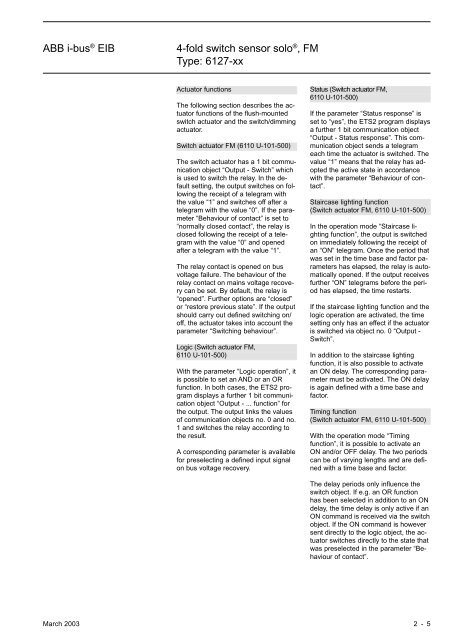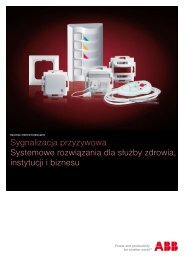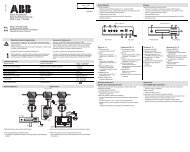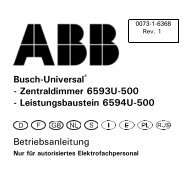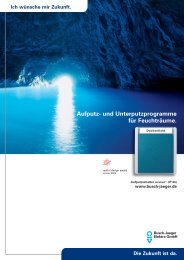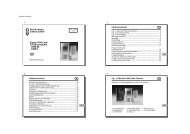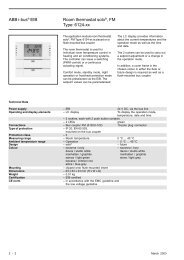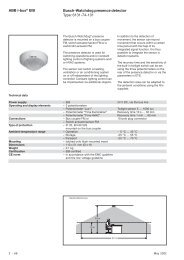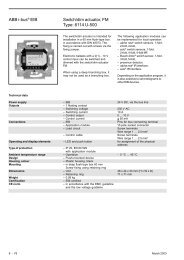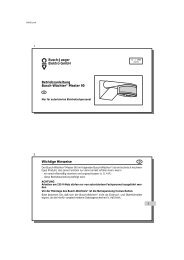ABB i-bus® EIB 4-fold switch sensor solo®, FM Type: 6127-xx
ABB i-bus® EIB 4-fold switch sensor solo®, FM Type: 6127-xx
ABB i-bus® EIB 4-fold switch sensor solo®, FM Type: 6127-xx
You also want an ePaper? Increase the reach of your titles
YUMPU automatically turns print PDFs into web optimized ePapers that Google loves.
<strong>ABB</strong> i-bus ® <strong>EIB</strong>4-<strong>fold</strong> <strong>switch</strong> <strong>sensor</strong> solo ® , <strong>FM</strong><strong>Type</strong>: <strong>6127</strong>-<strong>xx</strong>Actuator functionsThe following section describes the actuatorfunctions of the flush-mounted<strong>switch</strong> actuator and the <strong>switch</strong>/dimmingactuator.Switch actuator <strong>FM</strong> (6110 U-101-500)The <strong>switch</strong> actuator has a 1 bit communicationobject “Output - Switch” whichis used to <strong>switch</strong> the relay. In the defaultsetting, the output <strong>switch</strong>es on followingthe receipt of a telegram withthe value “1” and <strong>switch</strong>es off after atelegram with the value “0”. If the parameter“Behaviour of contact” is set to“normally closed contact”, the relay isclosed following the receipt of a telegramwith the value “0” and openedafter a telegram with the value “1”.The relay contact is opened on busvoltage failure. The behaviour of therelay contact on mains voltage recoverycan be set. By default, the relay is“opened”. Further options are “closed”or “restore previous state”. If the outputshould carry out defined <strong>switch</strong>ing on/off, the actuator takes into account theparameter “Switching behaviour”.Logic (Switch actuator <strong>FM</strong>,6110 U-101-500)With the parameter “Logic operation”, itis possible to set an AND or an ORfunction. In both cases, the ETS2 programdisplays a further 1 bit communicationobject “Output - ... function” forthe output. The output links the valuesof communication objects no. 0 and no.1 and <strong>switch</strong>es the relay according tothe result.A corresponding parameter is availablefor preselecting a defined input signalon bus voltage recovery.Status (Switch actuator <strong>FM</strong>,6110 U-101-500)If the parameter “Status response” isset to “yes”, the ETS2 program displaysa further 1 bit communication object“Output - Status response”. This communicationobject sends a telegrameach time the actuator is <strong>switch</strong>ed. Thevalue “1” means that the relay has adoptedthe active state in accordancewith the parameter “Behaviour of contact”.Staircase lighting function(Switch actuator <strong>FM</strong>, 6110 U-101-500)In the operation mode “Staircase lightingfunction”, the output is <strong>switch</strong>edon immediately following the receipt ofan “ON” telegram. Once the period thatwas set in the time base and factor parametershas elapsed, the relay is automaticallyopened. If the output receivesfurther “ON” telegrams before the periodhas elapsed, the time restarts.If the staircase lighting function and thelogic operation are activated, the timesetting only has an effect if the actuatoris <strong>switch</strong>ed via object no. 0 “Output -Switch”.In addition to the staircase lightingfunction, it is also possible to activatean ON delay. The corresponding parametermust be activated. The ON delayis again defined with a time base andfactor.Timing function(Switch actuator <strong>FM</strong>, 6110 U-101-500)With the operation mode “Timingfunction”, it is possible to activate anON and/or OFF delay. The two periodscan be of varying lengths and are definedwith a time base and factor.The delay periods only influence the<strong>switch</strong> object. If e.g. an OR functionhas been selected in addition to an ONdelay, the time delay is only active if anON command is received via the <strong>switch</strong>object. If the ON command is howeversent directly to the logic object, the actuator<strong>switch</strong>es directly to the state thatwas preselected in the parameter “Behaviourof contact”.March 2003 2 - 5


